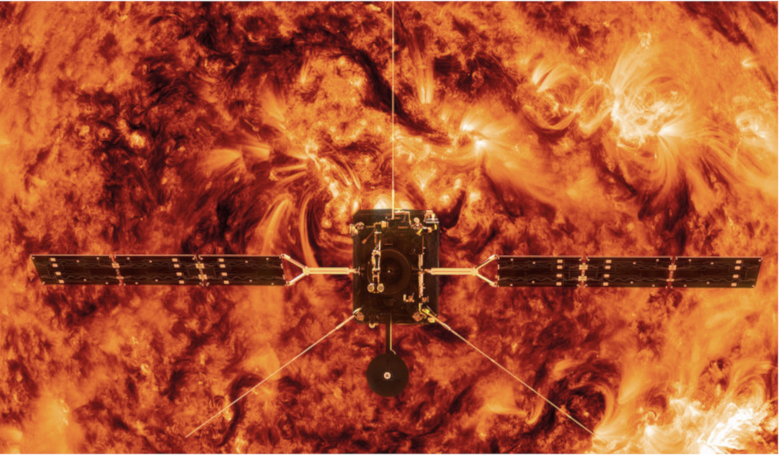After months of nerve-wracking simulation training, the European Space Agency’s mission control is counting down the hours to the launch of their Solar Orbiter mission.
Scheduled for launch Monday 10 February 04:03 GMT (05:03 CET) on top of an Atlas V rocket from Space Launch Complex 41 on Cape Canaveral Air Force Station in Florida, Solar Orbiter will fly closer to the Sun than any European spacecraft in history to study our nearest star in exquisite detail.
One of the first hurdles Solar Orbiter needs to perfect is the Launch and Early Orbit Phase (LEOP). This is a critical and risky part of the mission’s lifetime when the spacecraft is programmed to ‘wake up’ and its solar panels and instrument booms are deployed.
The boom, which measures 4.4 metres in length when fully extended, is to keep away four of Solar Orbiter’s scientific measuring instruments away from the main body of the spacecraft and any potential interference.
If the boom fails to deploy on time, the craft could be more restricted in which thrusters it can use to control the spacecraft’s orientation, or ‘attitude’.
“The booms are deployed before all thrusters can be fired on the spacecraft, as some thrusters can potentially contaminate the instruments onboard,” explains Andrea Accomazzo, Flight Director for the mission.
“The sooner all thrusters can be fired, the more efficiently they can be used and more fuel can be saved”.
Once in its initial cruise phase, which lasts until November 2021, Solar Orbiter will perform two gravity-assist manoeuvres around Venus and one around Earth and a series of chemical thruster burns to slingshot it out of the ecliptic plane of the Solar System so that it can capture close-up images of never before seen regions of our parent star, such as the poles.
A cutting-edge heatshield technology will ensure the spacecraft’s scientific instruments are protected as they face the searing solar heat. At its closest, Solar Orbiter will come within about 42 million kilometres of the Sun: closer than the scorched inner planet Mercury, where it will face blistering temperatures of up to 500°C.
Solar Orbiter’s mission objective is to collect data on the Sun’s turbulent solar surface, its hot outer atmosphere and changes in the solar wind with a combination of ten in situ and remote-sensing instruments.
These include an Energetic Particle Detector, to measure the composition, timing and distribution functions of suprathermal and energetic particles; a magnetometer to provide in situ measurements of the heliospheric magnetic field with high precision and a Radio and Plasma Waves experiment to measure magnetic and electric fields at high time resolution, plus many remote-sensing instruments to image the Sun in various wavelengths.
"There are dozens if not hundreds of science topics where we hope to make progress," Chris St. Cyr, a scientist who has worked on the spacecraft, said in a briefing in January. "Several years from now, you will see the first images of the sun's pole and the magnetic field," St. Cyr said.
The first close solar pass is expected to take place at the end of March 2022 at around a third of the distance between Earth and the Sun. At this point, the spacecraft will be in an elliptical orbit that initially takes 180 days to complete, making a close approach of the Sun every six months.
Solar Orbiter will continue to peek above the ‘plane of the ecliptic’ – the same flat plane around the Sun that the planets, moons and minor bodies of the Solar System orbit in – by following a constantly changing elliptical path that will be continually tilted and squeezed, edging it higher and higher and closer to the Sun’s poles.
As such, the spacecraft’s orbit has been chosen to be ‘in resonance’ with Venus, meaning it will return to the planet’s vicinity every few orbits so that it use Venus’ gravity to alter or tilt its orbit.
Data gathered by Solar Orbiter will be stored on the spacecraft, then ‘downlinked’ (or beamed) to Earth during eight-hour communication windows, via the 35 metre Malargüe ground station in Argentina. Ground stations in New Norcia, Australia, and Cebreros, Spain, will be acting as backup when necessary.
This ESA-led mission with strong NASA participation, will also work closely with the US agency’s Parker Solar Probe, by collecting complementary datasets that will allow more science to be extracted from the two missions than either could achieve on their own.
The Parker Solar Probe, which launched in August 2018, has just made its closest approach to the Sun on 20 January 2020 getting within 18,696,529 kilometres of the fiery surface, breaking both distance and speed records as it did so.
Now though, all eyes will be on ESA’s solar mission after Accomazzo took to Twitter following the pre-launch briefing today to announce that, “Mission control is green for launch!"
“We have more than 100 years of combined experience flying space missions in our division, from the Rosetta landing, to BepiColombo and Venus Express,” says Sylvain Lodiot, Spacecraft Operations Manager for the mission.
“We’re now looking forward to seeing the Sun in a light no-one has before”.
You can watch the launch live via https://www.esa.int/esawebtv starting at 03:15 GMT (04:15 CET) Monday 10 February.











